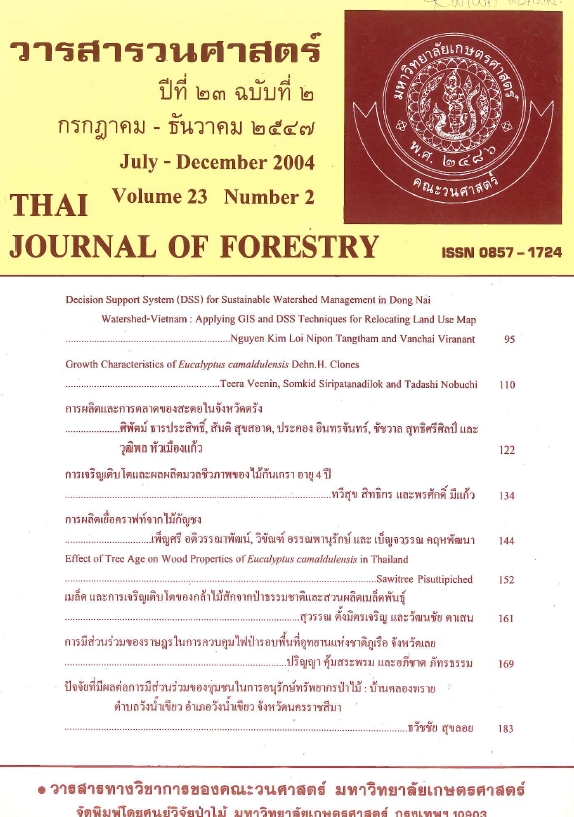การผลิตและการตลาดของสะตอในจังหวัดตรัง
Main Article Content
บทคัดย่อ
การศึกษาครั้งนี้มีวัตถุประสงค์เพื่อศึกษาการผลิตและการตลาดของสะตอในจังหวัดตรัง เก็บรวบรวมข้อมูล โดยวิธีสัมภาษณ์ผู้เก็บหาสะตอ ผู้ปลูกสะตอ และผู้จำหน่ายสะตอ นำข้อมูลมาวิเคราะห์หาค่าความถี่ ค่าร้อยละ ค่าเฉลี่ย ค่าต่ำสุด และค่าสูงสุด ผลการศึกษาพบว่า ผู้เก็บหาสะตอในป่าธรรมชาติไปเก็บหาสะตอเพียงคนเดียวมีมากที่สุดร้อยละ 60 เป็นเพศชายมากกว่าเพศหญิง ระยะทางจากบ้านถึงจุดที่เก็บหาสะตอเฉลี่ย 4.1 กิโลเมตร ใช้เวลาในการเก็บเฉลี่ย 3 ชั่วโมงต่อวัน วิธีการเก็บหาสะตอที่พบมากที่สุดคือใช้ไม้สอย ในปี พ.ศ. 2544 และ 2545 ปริมาณสะตอที่เก็บได้ทั้งหมดประมาณ 920,900 ฝัก และ 904,270 ฝัก ตามลำดับการนำสะตอไปจำหน่ายผู้เก็บหาน้ำสะตอไปขายเองเป็นส่วนใหญ่ และพอใจในราคาที่จำหน่ายได้ รายได้จากการเก็บหาสะตอเฉลี่ย 23,000 บาทต่อปี ด้านผู้ปลูกสะตอพบว่ามีพื้นที่ปลูกสะตอต่ำสุด 4 ไร่ สูงสุด 11 ไร่ และเฉลี่ย 6.3 ไร่ต่อราย โดยปลูกสะตอร่วมกับไม้ชนิดอื่นคือ ยางพารา มังคุด ทุเรียน ขนุน และลองกอง พันธุ์สะตอที่ปลูกคือสะตอข้าวและสะตอดาน ให้ผลผลิตในปีที่ 7 หรือปีที่ 8 ปริมาณสะดอที่เก็บได้จากป่าธรรมชาติในปี พ.ศ. 2544 และ 2545 มีปริมาณเท่ากับ 152,900 ฝัก และ 198, 100 ฝัก ตามลำดับรายได้จากการปลูกสะตอเฉลี่ย 81,500 บาทต่อปี ผู้จำหน่ายสะตอซื้อสะตอมาจากชาวบ้านคิดเป็นร้อยละ 92.86 เหตุผลที่ทำธุรกิจจำหน่ายสะตอ เพราะตลาดมีความต้องการสะตอมาก และขายได้กำไรสูง สะตอที่จำหน่ายเป็นสะตอข้าวและสะตอตาน การคัดเลือกสะตอเพื่อจำหน่ายดูการสุกของเมล็ดเป็นหลัก ในปี พ.ศ. 2544 และ 2545 พบว่าปริมาณสะตอที่จำหน่ายเท่ากับ 4,428,500 ฝัก และ 3,976,800 ฝึก ตามลำดับราคาของสะตอข้าวและสะตอดานอยู่ในช่วง 200 - 400 บาทต่อ 100 ฝึก หน่วยงานของรัฐที่รับผิดชอบในพื้นที่ที่ผู้เก็บหาเข้าไปเก็บสะตอควรให้ความรู้ และแนะนำวิธีการที่ถูกต้องในการเก็บสะตอ เพื่อไม่ให้เกิดผลกระทบต่อสภาพแวดล้อม และไม่ทำลายต้นสะตอที่ถูกเก็บผลผลิต ตลอดจนส่งเสริมให้ราษฎรที่เข้าไปเก็บหาสะตอในป่าธรรมชาติที่มีที่ดินเป็นของตนเองปลูกสะตอร่วมกับพืชชนิดอื่นที่ปลูกไว้แล้ว
Downloads
Article Details

อนุญาตภายใต้เงื่อนไข Creative Commons Attribution-NonCommercial-NoDerivatives 4.0 International License.
ข้าพเจ้าและผู้เขียนร่วม (ถ้ามี) ขอรับรองว่า ต้นฉบับที่เสนอมานี้ยังไม่เคยได้รับการตีพิมพ์และไม่ได้อยู่ในระหว่างกระบวนการพิจารณาตีพิมพ์ลงในวารสารหรือสิ่งตีพิมพ์อื่นใด ข้าพเจ้าและผู้เขียนร่วม (ถ้ามี) ยอมรับหลักเกณฑ์และเงื่อนไขการพิจารณาต้นฉบับ ทั้งยินยอมให้กองบรรณาธิการมีสิทธิ์พิจารณาและตรวจแก้ต้นฉบับได้ตามที่เห็นสมควร พร้อมนี้ขอมอบลิขสิทธิ์ผลงานที่ได้รับการตีพิมพ์ให้แก่วารสารวนศาสตร์ คณะวนศาสตร์ มหาวิทยาลัยเกษตรศาสตร์ กรณีมีการฟ้องร้องเรื่องการละเมิดลิขสิทธิ์เกี่ยวกับภาพ กราฟ ข้อความส่วนใดส่วนหนึ่ง หรือ ข้อคิดเห็นที่ปรากฏในผลงาน ให้เป็นความรับผิดชอบของข้าพเจ้าและผู้เขียนร่วม (ถ้ามี) แต่เพียงฝ่ายเดียว และหากข้าพเจ้าและผู้เขียนร่วม (ถ้ามี) ประสงค์ถอนบทความในระหว่างกระบวนการพิจารณาของทางวารสาร ข้าพเจ้าและผู้เขียนร่วม (ถ้ามี) ยินดีรับผิดชอบค่าใช้จ่ายทั้งหมดที่เกิดขึ้นในกระบวนการพิจารณาบทความนั้น”


